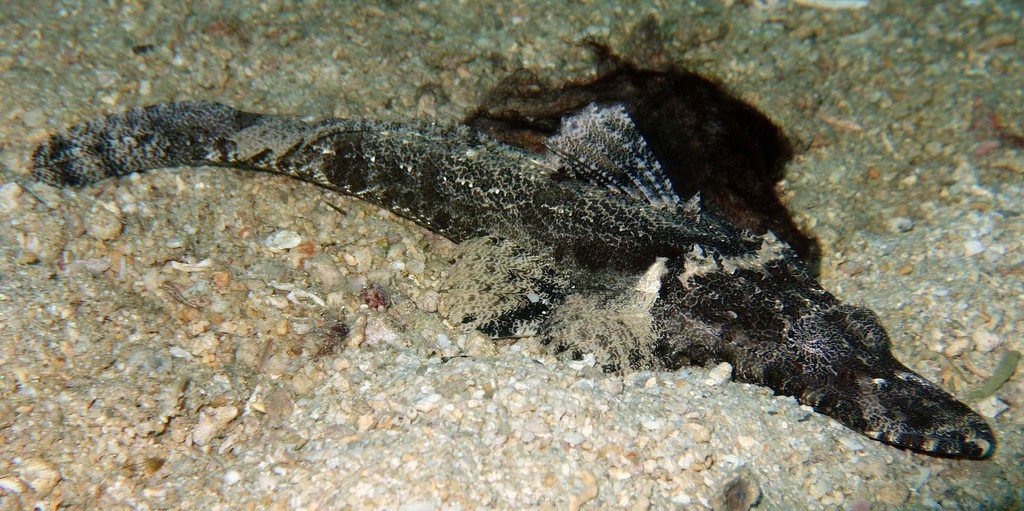CYMBACEPHALUS BEAUFORTI - (KNAPP, 1973)
Picture courtesy of: Alain Daoulas
Poisson-crocodile de Beaufort, Crocodile fish, De Beaufort's flathead, Giant flathead, Krokodillefisk, Enma Gochi, エンマゴチ, 博氏孔鯒,
Synonyme
Platycephalus beauforti (Knapp, 1973)
--------------------------
Description
Dorsal spines (total): 9-10; Dorsal soft rays (total): 11; Anal fin rays: 11; Pectoral fin rays: 19-21 (usually: 20); Pelvic fin rays: I, 5; Vertebrae: 11-12 + 15-16 = 27. Body elongate, head moderately depressed. Rear edge of maxilla ends well in front of eye. Prominent pit present behind upper eye. Preopercular spines short, usually: 2 subequal, rarely: 3. Supraorbital ridge usually smooth over eye, bearing a few small spines posteriorly. Preorbital spines lacking; A single preocular spine; Suborbital ridge largely smooth, bearing 2 spines below eye. Teeth on vomer in 2 separate patches. Lower side of head bicarinate. Iris lappet cirrose. Dermal papillae (10-12 in adults) on upper eye, some simple, some branched, longest not reaching above supraorbital ridge. Interopercular flap usually broader than long, with several subdivisions. Total gill rakers on first gill arch: 5-6 (usually: 6). Oblique scale rows slanting backward above lateral line more or less equal to number of lateral-line scales. Lateral line scales: 50-55 (usually: 52-53), anterior: 1-3 scales bearing a weak spine. Scale pores of lateral line with a single opening to the exterior. Max. length: 50.0 cm TL, common length: 35.0 cm TL. Depth range: 1 - 12 m, usually: 2 - 3 m.
Color
Small juveniles all black, gradually changing to the blotched pattern of the adult. Body dark brown above, lower sides frequently with irregular dark brown blotches, pale below, breast with brown streaks in some; All fins mottled with small to large dark blotches.
Etymology
Cymbacephalus: from Latin, cymba = a boat, skiff, first used by the Phoenicians; Especially the small boat used by Charon to ferry the dead + from Greek, kephale = head.
beauforti: this species is named in honor of the late Dr. L. F. de Beaufort who, in addition to his many notable contributions to ichthyology, at die age of 88 wrote a most informative and encouraging letter to me concerning the need for a revision of the Platycephalidae.
Original description: beauforti, Platycephalus (Cymbacephalus) Knapp, 1973 - Type locality: off Urukthapel Island, Palau Islands, Garamejo region, Ngaremedin District, Pacific, 7°15'15"N, 134°26'51"E; H. A. Fehlmann and party; 31 July 1955.
Distribution
Western Pacific: Indonesia east to Palau and Yap (Micronesia), north to Ryukyu Islands (Japan), south to New Caledonia.
Biology
Lives on sand or rubble substrates of sheltered or semi-exposed reefs. Well camouflaged on reefs. Also found in coral reefs and mangrove area. Presumably primarily piscivorous, also large benthic crustaceans.
Similar species
Papilloculiceps longiceps (Cuvier, 1829) - Reported from Red Sea; Western Indian Ocean: Gulf of Aden, Socotra and Gulf of Oman south to northern South Africa, east to Madagascar and Seychelles; Mediterranean Sea (Red Sea immigrant). Max. length: 70.0 cm TL, common length: 50.0 cm TL.
Cymbacephalus nematophthalmus (Günther, 1860) - Reported from Eastern Indian Ocean, western Pacific: Malaysia and Indonesia east to Philippines and New Ireland (Papua New Guinea), south to Shark Bay (Western Australia) and northern New South Wales (Australia). Max. length: 58.0 cm TL, common length: 30.0 cm TL.
Cymbacephalus parilis (McCulloch, 1914) - Reported from Eastern Indian Ocean, southwestern Pacific: Shark Bay (Western Australia) around northern Australia to Brisbane (Queensland); Gulf (Papua New Guinea). Max. length: 51.0 cm TL.
Last update: 11, August 2022
